
Ceratophora is a genus of agamid lizards found in Sri Lanka. The male has a horn on its snout.

Laudakia is a genus of lizards, commonly known as Asian rock agamas, in the family Agamidae. The genus is found mostly in Asia, with some species in Southern Europe.

Salea is a genus of arboreal, slow-moving, diurnal, insectivorous, egg-laying agamid lizards endemic to the Western Ghats of South India. It has two species, each inhabiting very high mountainous tracts of the Western Ghats in the Shola forest ecosystems.
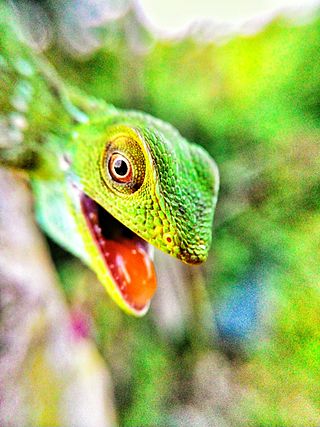
Bronchocela jubata, commonly known as the maned forest lizard, is a species of agamid lizard found mainly in Indonesia on the islands of Singkep, Java, Bali, Sulawesi, Karakelang, Salibabu; Nias Island, Singkap Island, Borneo (Kalimantan) also in Thailand, Cambodia and Philippines. Although in the past it was thought the species may be found in India, either on the mainland or in the Nicobars, this is not the case according to herpetologist Das. It is also known by the common name of "bloodsucker", although this is a misnomer.

Calotes calotes, the common green forest lizard, is an agamid lizard found in the forests of the Western Ghats and the Shevaroy Hills in India, and Sri Lanka.

Calotes mystaceus, the Indo-Chinese forest lizard or blue crested lizard, is an agamid lizard found in China, South Asia and Southeast Asia.
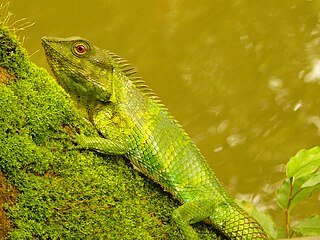
Calotes nemoricola, the Nilgiri forest lizard, is an agamid lizard found in the Western Ghats of India.

Draco blanfordii, commonly known as Blanford's flying dragon, Blanford’s flying lizard, or Blanford's gliding lizard, is a species of "flying" lizard in the family Agamidae. The species is endemic to Asia, and is capable of gliding from tree to tree.
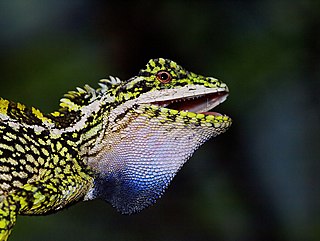
The variegated mountain lizard or Himalayan dragon is an agamid lizard found in northern India, Bhutan, and Nepal.

The Caucasian agama is a species of agamid lizard found in the Caucasus, E/S Georgia, Armenia, Azerbaijan, Turkmenistan, Tajikistan, Dagestan (Russia), E Turkey, Iraq, N Iran, Afghanistan, NW Pakistan, and parts of Kashmir.

Laudakia tuberculata is a species of agamid lizard found in northern Pakistan, northern India, Nepal, eastern Afghanistan, and western China.

The peninsular rock agama or South Indian rock agama is a common species of agama found on rocky hills in south India. An allied species, Psammophilus blanfordanus, is found in the Eastern Ghats, but north of the range of this species.
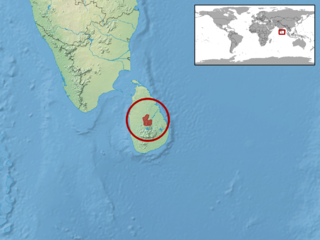
The Kandyan day gecko or Kandyan rock gecko is a species of diurnal gecko found in Sri Lanka.

The Malayan forest gecko or banded bent-toed gecko is a species of gecko found in Southeast Asia.
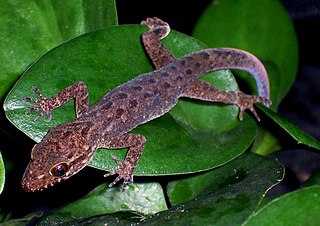
The marbled bow-fingered gecko is a species of gecko found in Southeast Asia.
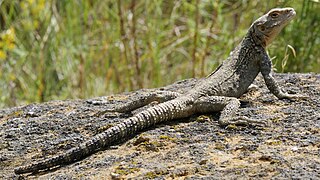
Paralaudakia is a genus of lizards, commonly known as Asian rock agamas, which are endemic to Eurasia.
The gibber earless dragon also known as the smooth-snouted earless dragon, is a species of agamid lizard endemic to Australia. It is one of a documented species of the genus Tympanocryptis, a group of small terrestrial lizards that feed off invertebrates and are characterised by the absence of an external ear structure.
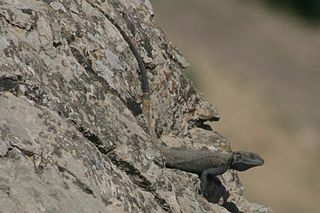
Laudakia nupta is a species of lizard from Iraq, Iran, Afghanistan, and Pakistan. It was described in 1843. There are two subspecies, Laudakia nupta nupta and Laudakia nupta fusca.
















